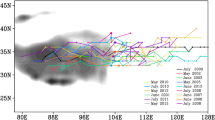Summary
Some of the vortices which develop over the Tibetan plateau during summer give rise to severe weather over eastern China. These weather developments can be difficult to forecast, but have been simulated successfully in a recently developed numerical model. It will be shown that different vortices respond differently to topographic effects, to nonlinear processes and to sensible and latent heating in their formation, maintenance, and motion. Elevated terrain appears to enhance the influence of thermodynamic processes, block airflow, and increase frictional dissipation.
Sensible heating sometimes collaborates with topography in blocking cold air intrusions and is not only a function of terrain elevation but also of the synoptic situation. Without the input of latent heating, vortices over the eastern part of the Tibetan plateau tend to degenerate.
Zusammenfassung
Einige der sich im Sommer über dem Hochland von Tibet entwickelnden Wirbel verursachen Unwetter in Ostchina. Die Vorhersage dieser Entwicklung kann schwierig sein, sie werden aber von einem kürzlich vorgestellten numerischen Modell erfolgreich simuliert. Es wird gezeigt, daß verschiedene Wirbel verschieden auf die Orographie, auf nichtlineare Vorgänge sowie auf fühlbare und latente Wärme in ihrer Entstehung, Erhaltung und Bewegung reagieren. Ein Hochland scheint den Einfluß thermodynamischer Vorgänge zu verstärken, Strömungen zu blockieren und die Reibungsdissipation zu steigern.
Die fühlbare Wärme verhindert manchmal gemeinsam mit der Topographie Kaltlufteinbrüche, hängt aber nicht nur von der Hochland-sondern auch von der synoptischen Situation ab. Ohne latente Wärme neigen Wirbel über dem Ostteil des Hochlandes von Tibet zur Degeneration.
Similar content being viewed by others
References
Anthes RA, Kuo YH, Benjamin SG, Li YF (1982) The evolution of the mesoscale environment of severe local storms: Preliminary modeling results. Mon Weath Rev 110: 1187–1213
Anthes RA, Kuo YH, Gyakum JR (1983) Numerical simulations of a case of explosive marine cyclogenesis. Mon Weath Rev 111: 1174–1188
Chang CB, Perkey DJ, Kreitzberg CW (1982) A numerical case study of the effects of latent heating on a developing wave cyclone. J Atmos Sci 38: 1555–1570
Chen LX, Reiter ER, Feng ZQ (1985) The atmospheric heat source over the Tibetan Plateau from May to August, 1979. Mon Wea Rev 113: 1771–1790
Chen SJ, Dell'Osso L (1984) Numerical prediction of the heavy rainfall vortex over eastern Asia monsoon region. J Met Soc Japan 62: 730–747
Cressman GP (1960) Improved terrain effects in barotropic forecasts. Mon Weath Rev 88: 327–342
Kuo HL (1965) On formation and intensification of tropical cyclones through latent heat release by cumulus convection. J Atmos Sci 22: 40–63
Kuo H, Qian, YF (1981) Influence of the Tibetan Plateau and the cumulative and diurnal changes of weather and climate in summer. Mon Weath Rev 109: 2337–2356
Lu JN, Qian ZG, Shan FM (1984) Research on the Qinghai-Xizang Plateau low in summer. International symposium on the Qinghai-Xizang (Tibet) Plateau and mountain meteorology, Beijing, PRC, March 20–24
Reiter ER, Reiter GJ (1981) Tibet — the last frontier. Bull Am Met Soc 62: 4–13
Shen RJ, Huang FJ (1984) The spectrum analysis on weather systems in middle troposphere over the Qinghai-Xizang Plateau and its adjacent regions in the summer 1979. Selected papers of the Qinghai-Xizang Plateau Meteorological Experiment (QXPMEX) (3), Science Press, Beijing, PRC (in press)
Shen RJ, Reiter ER, Bresch JF (1985) A simplified hydrodynamic model suitable for mesoscale and subsynoptic weather systems over plateau regions. Arch Met Geoph Biocl, in press
Shen RJ, Zhang BY (1982) The effect of latent heating on the distribution of the precipitation of typhoons. Scientia Atmospherica Sinica 6: 249–237 (in Chinese)
Tao SY, Zhang HG, Luo S (1984) The Qinghai-Xizang Plateau Meteorological Experiment (QXPMEX) in May–August 1979. International symposium on the Qinghai-Xizang (Tibet) Plateau and mountain meteorology, Beijing, PRC, March 20–24
Xu XN, Jiao PJ (1985) On the structure of the Chang Jiang (Yangzi) and the Huaihe River cyclones in summer. Submitted to Scientia Atmospherica Sinica for publication
Author information
Authors and Affiliations
Additional information
With 22 Figures
Rights and permissions
About this article
Cite this article
Shen, R., Reiter, E.R. & Bresch, J.F. Numerical simulation of the development of vortices over the Qinghai-Xizang (Tibet) Plateau. Meteorl. Atmos. Phys. 35, 70–95 (1986). https://doi.org/10.1007/BF01029526
Received:
Revised:
Issue Date:
DOI: https://doi.org/10.1007/BF01029526




